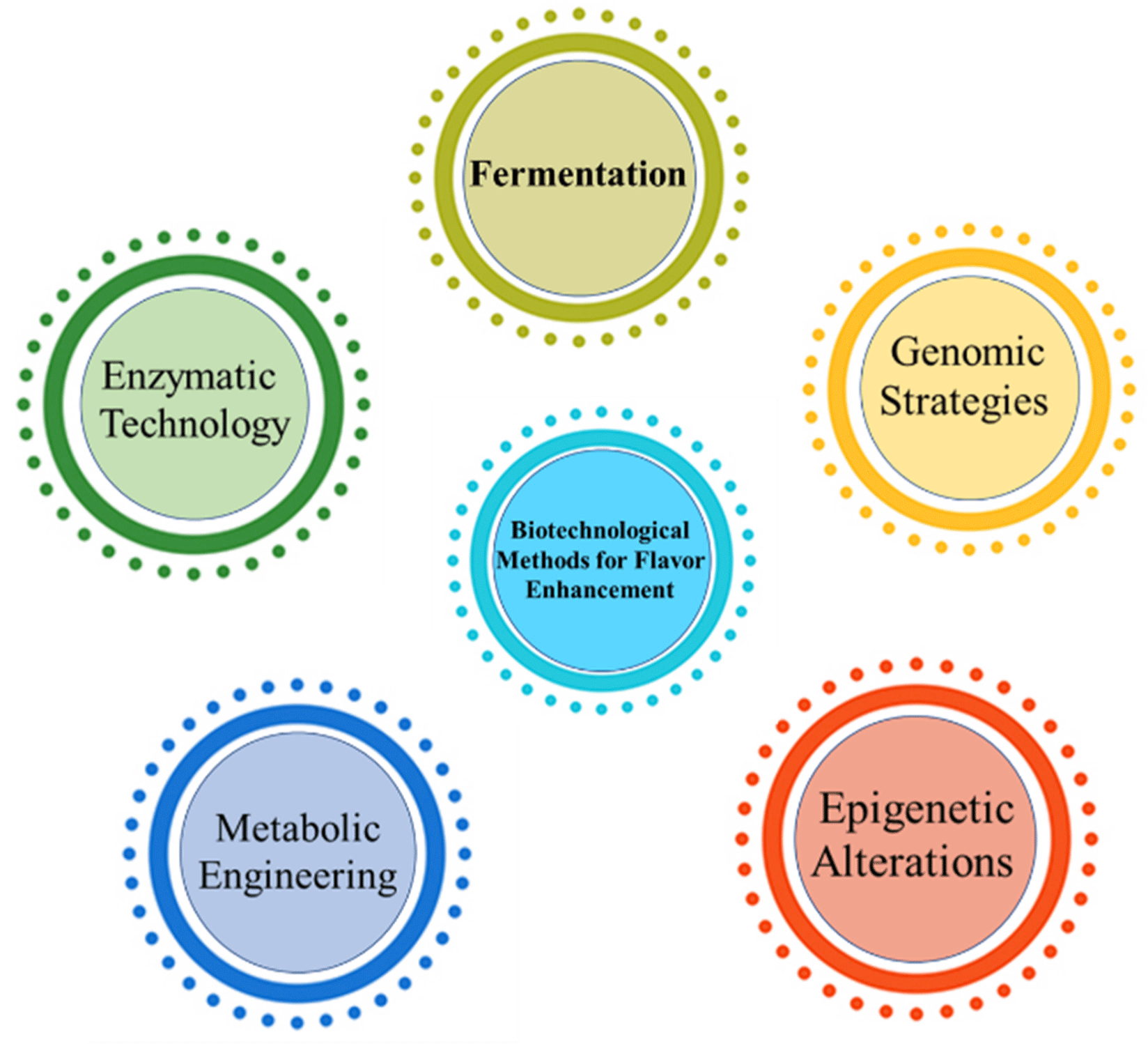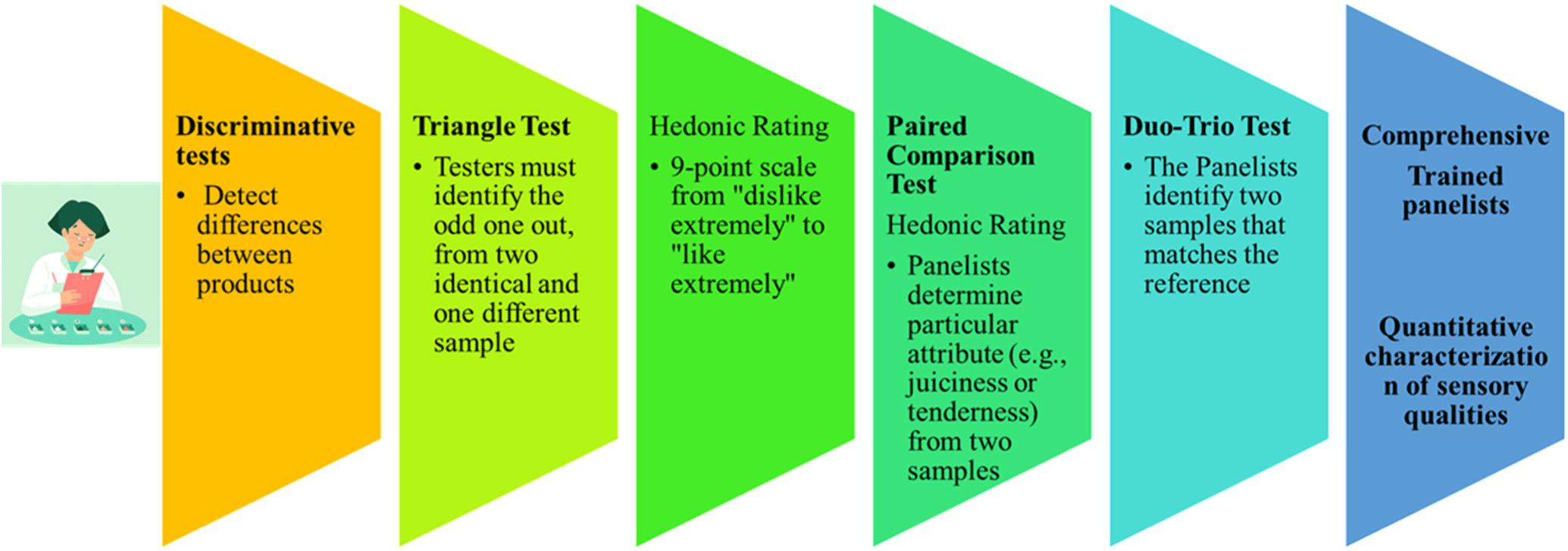Introduction
The sensory experience of meat intake is significantly affected by its flavor and taste, which are essential for consumer acceptance and market value. As customer preferences shift, influenced by heightened awareness of health, sustainability, and culinary diversity, the meat business encounters a rising demand for superior flavor development (Hossain et al., 2024; Zhang et al., 2021). The intricacy of meat flavor results from the interplay of several substances, including amino acids, peptides, lipids, and volatiles, which are affected by variables such as animal species, food, and processing techniques (Jiang et al., 2024). Understanding these complex interactions, researchers and industry experts have pursued novel methods to improve and alter the flavor profiles of meat products to satisfy contemporary customer expectations. Traditional methods for flavor development in meat include dry and wet aging, marination, and smoking (Alam et al., 2024d). These traditional methods facilitate biological reactions that enhance the umami, sweetness, and overall complexity of meat’s flavor. Nonetheless, recent developments in food technology are expanding the limits of flavor enhancement by offering innovative methods that utilize enzymatic activity, microbial fermentation, and improved flavor encapsulation technologies (Wang et al., 2022). Microbial transglutaminase (MTGase) has become a favored binding agent, enhancing texture and affecting flavor release in meat products (Chen et al., 2023).
The integration of artificial intelligence (AI) and big data analytics in the meat business is revolutionizing taste formulation methodologies. Data-driven models currently aid in forecasting consumer preferences, enhancing component interactions, and formulating tailored flavor profiles (Al-Ali et al., 2024). The integration of classic and contemporary techniques offers promising prospects to enhance and vary meat flavor profiles, improving both palatability and market attractiveness of meat products.
This review will examine contemporary techniques and upcoming trends in flavor and taste production in meat, highlighting developments in both classic and creative methodologies. This research seeks to elucidate how contemporary literature and industry practices are influencing the future of meat taste engineering in response to evolving customer needs.
Exploring the Biochemical Mechanisms of Flavor and Taste in Meat
Flavor and taste characteristics result from a complex interaction of chemical substances and sensory mechanisms, which collectively enhance a product’s overall palatability. Taste, as conventionally defined, relates to the five fundamental gustatory sensations: sweet, sour, salty, bitter, and umami. Flavor is a composite of taste, scent, and supplementary sensations, including texture, mouthfeel, and visual cues, resulting in a multimodal experience that influences consumer satisfaction across various sensory dimensions (Shahidi and Zhong et al., 2005; Smith et al., 2018).
The flavor profile of meat is shaped by intrinsic characteristics, including species, age, and muscle type, alongside extrinsic ones such as diet, cooking style, and aging processes (Mottram, 1998). Principal factors influencing meat flavor encompass the Maillard reaction, lipid oxidation, and nucleotide degradation during cooking. The Maillard reaction, occurring between amino acids and reducing sugars at elevated temperatures, generates various volatile chemicals that provide cooked meat with its distinctive roasted and caramelized aromas (Nursten, 2005). Lipid oxidation is a crucial process that enhances flavor by producing aldehydes, ketones, and hydrocarbons, imparting meat its distinctive scent and sensory complexity (Mottram, 1998).
Fifth Fundamental Tastes “Umami”
Among the five fundamental tastes, umami is especially important in the flavor of meat. The umami flavor, mostly originating from amino acids like glutamate and nucleotides such as inosinate, contributes to the richness and complexity characteristic of premium meat products (Kurihara, 2009). Research indicates that aging processes, including wet and dry aging, might augment umami by decomposing proteins into glutamate and other umami-rich substances, hence enhancing the savory profile and overall sensory attractiveness of beef products (Ikeda, 2002; Son et al., 2024). Dry aging is recognized for augmenting the flavor of beef, yielding nutty and earthy undertones as a result of the enzymatic degradation of amino acids and lipids (Dashdorj et al., 2015). The ways of cooking significantly influence taste development. Grilling enhances the Maillard reaction and lipid oxidation, resulting in more pronounced flavors, while boiling or steaming produces a milder, less intricate flavor due to the restricted development of volatile chemicals (Zhong et al., 2021).
Numerous components, such as proteins, lipids, carbohydrates, and nucleotides, substantially influence the distinctive flavors experienced in meat. The influence of different compounds in the taste and flavor of food and meat are shown in Fig. 1. Meat is rich in proteins, and their decomposition during cooking or age liberates amino acids that are crucial for flavor enhancement. Amino acids, including glutamic acid, aspartic acid, and glycine, contribute to the umami flavor, whereas sulfur-containing amino acids such as methionine and cysteine produce appealing roasted or meaty odors upon heating (Herrera and Calkins, 2022; Mottram, 1998). Moreover, the Maillard reaction transpires between amino acids and reducing sugars during cooking, resulting in the creation of heterocyclic compounds that enhance the meat’s browned exterior and intricate flavor. The oxidation of polyunsaturated fatty acids (PUFAs) during cooking generates chemicals including aldehydes, ketones, and alcohols, which are crucial for developing distinct meat tastes. For example, oleic acid produces agreeable fragrances, whereas linoleic and linolenic acids impart aromatic characteristics reminiscent of roasted meat (Resconi et al., 2013). Intramuscular fat, or marbling, is recognized for augmenting flavor intensity and juiciness, since it influences the retention and release of volatile chemicals during cooking (Wood, 2004). Despite their minimal presence, carbohydrates in meat, including glycogen, glucose, and ribose, significantly contribute to flavor production. The caramelization of sugars at high temperatures enhances the rich, sweet flavors of cooked meat, improving its overall appeal (Mottram, 1998).
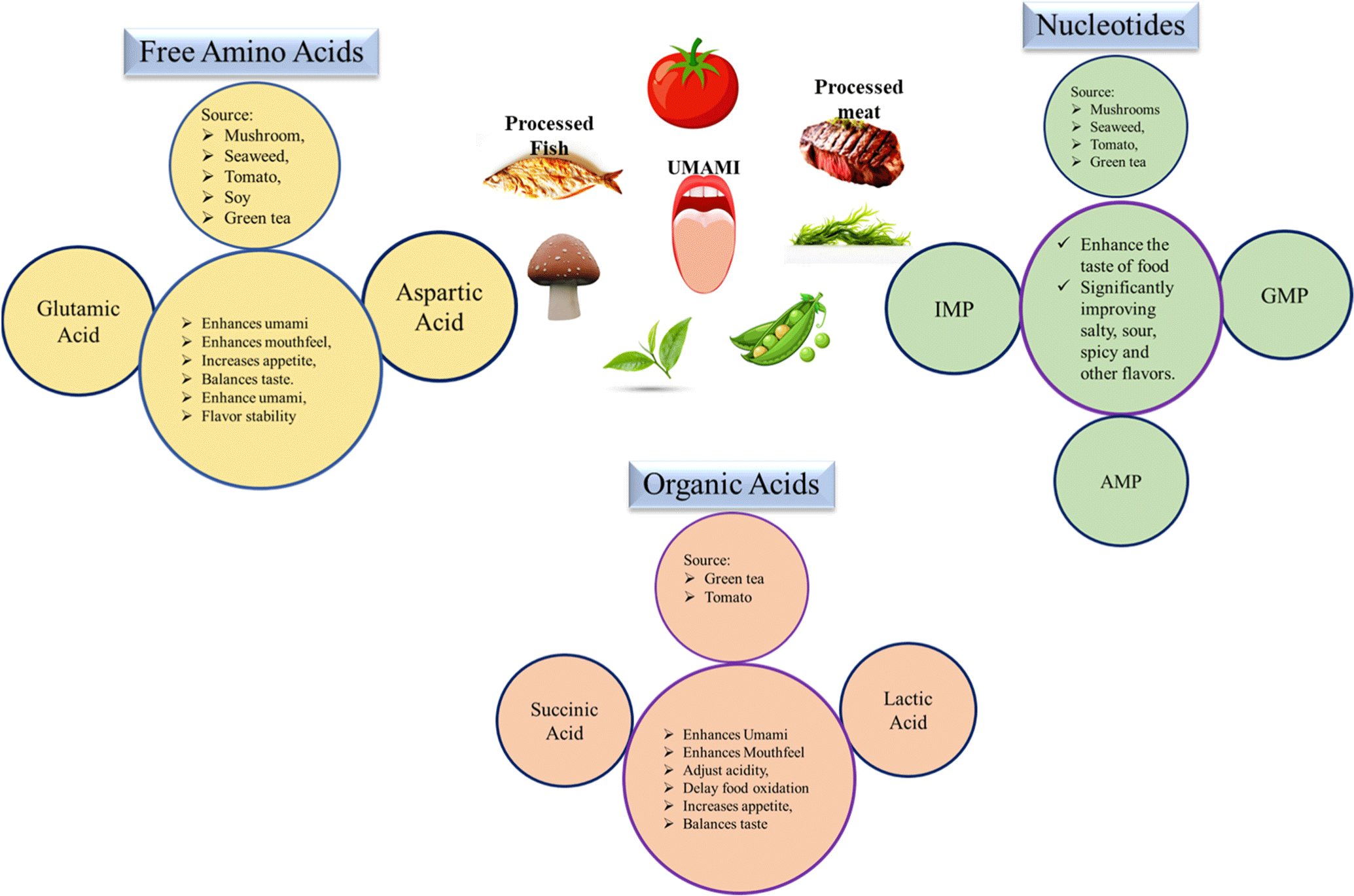
Nucleotides like inosine monophosphate and guanosine monophosphate are essential elements in the umami flavor characteristic of meat. These molecules, when amalgamated with amino acids such as glutamate, synergistically augment the umami flavor and complexity in meat (Tikk, 2008). Free amino acids and peptides contribute to flavor; notably, glutamic acid enhances the delicious profile of aged meat (Dashdorj et al., 2015).
Umami, one of the five fundamental sensations with sweet, sour, salty, and bitter, is sometimes described as the “savory” or “meaty” flavor. Initially recognized by Japanese chemist Kikunae Ikeda in 1908, umami arises from the presence of glutamate, inosinate, and guanylate, chemicals prevalent in numerous foods, particularly meats. This flavor elevates the culinary profile of dishes, delivering a sumptuous experience and an enduring aftertaste. The umami flavor predominantly originates from amino acids, particularly glutamate, and nucleotides, including inosinate and guanylate, which are naturally found in meat (Ikeda, 2002). The umami and other taste perception mechanism is illustrated in Fig. 2. Meat processing techniques such as curing and boiling can augment umami levels. With aging, proteolytic enzymes degrade muscle proteins, liberating free amino acids and nucleotides that enhance umami flavor. In goods like restructured meat or meat replacements, using umami sources (e.g., mushroom extracts, yeast extracts, or soy sauce) enhances sensory perception and improves palatability, hence increasing their appeal to consumers seeking meat-like experiences (Samad et al., 2024).
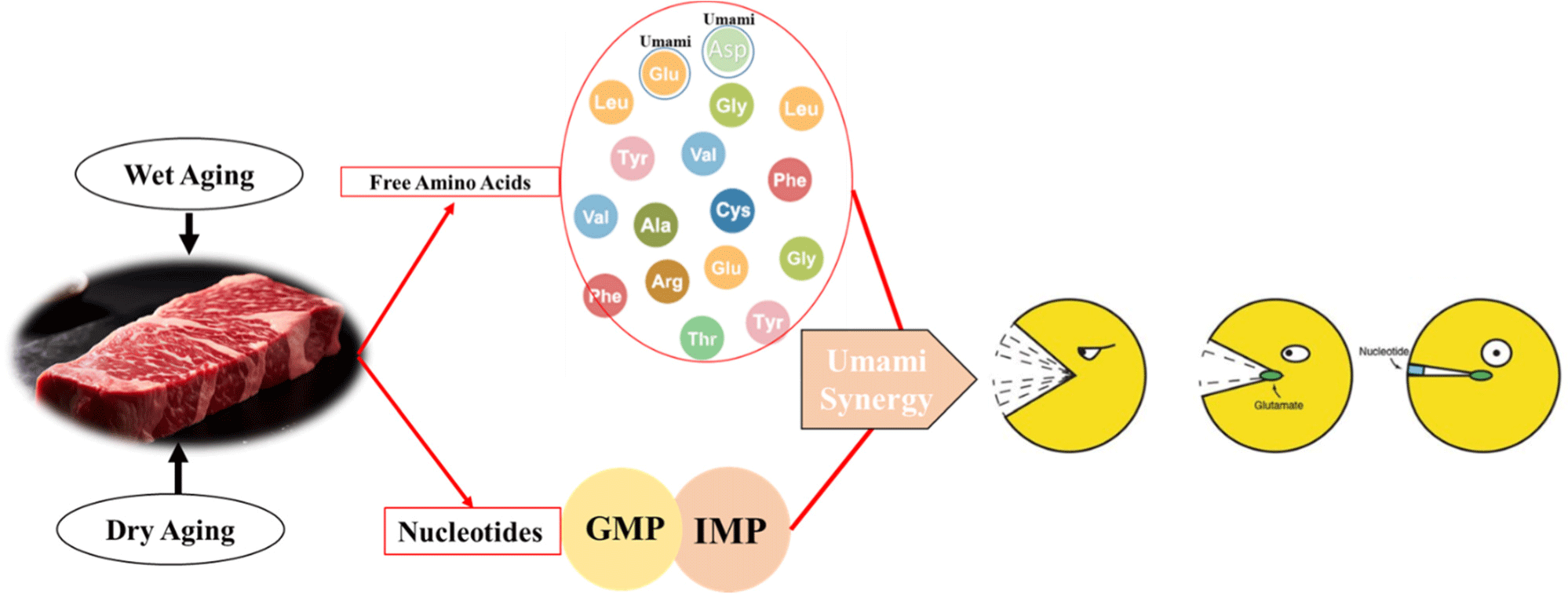
The Application of Sensory Science in the Investigation of Flavor Profiles in Meat
Progress in sensory research and analytical methodologies has facilitated a more accurate identification and comprehension of the chemical components that influence beef flavor (Alam et al., 2024a). Gas chromatography-mass spectrometry (GC-MS) enables researchers to identify and quantify volatile molecules, elucidating the chemical foundation of meat flavors. Furthermore, consumer sensory panels and descriptive sensory analysis facilitate the correlation of specific flavor traits with consumer preferences, enabling the meat sector to customize goods to satisfy consumer wants (Lawless and Heymann, 2010).
Influence of Processing Methods on the Chemical Composition of Food Matrixes
The chemical composition of meat and its resultant flavor are influenced by processing processes. Dry aging facilitates the enzymatic degradation of proteins and fats, hence augmenting the content of amino acids, peptides, and fatty acids that enhance umami and savory flavors (Wang et al., 2020). Cooking methods such as grilling, smoking, and frying induce thermal breakdown of lipids and proteins, resulting in the creation of distinctive volatile compounds and enhancing meat flavor (Resconi et al., 2013).
The Maillard reaction is a primary mechanism of taste production during heat processing. This reaction transpires between reducing sugars and amino acids, resulting in a sequence of intricate reactions that yield various chemicals, including melanoidins, which impart the distinctive brown hue and umami flavors in meat. The Maillard reaction is significantly influenced by temperature, generally taking place at temperatures over 140°C (Lea and Swoboda, 1962). Research indicates that elevated temperatures result in a greater formation of Maillard reaction products, hence intensifying flavor and color in restructured meat (Samad et al., 2024).
The chemicals generated during the Maillard reaction differ based on the amino acids and sugars involved. Cysteine and ribose generate sulfur-containing compounds, including mercaptans and thiazoles, which provide savory and meaty flavors, whereas phenylalanine yields molecules with a roasted and nutty fragrance (van Boekel, 2006). These reactions are controlled in restructured meat processing to maximize flavor profiles and augment customer attraction.
Lipid oxidation is a significant element in the flavor characteristic of thermally cooked meat. Upon heating, unsaturated fats experience oxidation, resulting in the production of aldehydes, ketones, and alcohols, which enhance the aroma and flavor of the product (Shahidi and Zhong, 2005). Lipid oxidation can impart appealing aromas, such the distinctive “grilled” scent; nevertheless, excessive oxidation may lead to undesirable off-flavors that diminish the overall sensory quality of restructured meat.
Diverse fat sources and compositions markedly influence flavor results. Products rich in polyunsaturated fats typically exhibit more pronounced oxidation products, which can augment flavor complexity while also heightening the risk of rancidity. Consequently, meticulous selection of fats and regulated thermal processing are crucial in the manufacture of restructured meat to attain a harmonious flavor profile devoid of undesirable notes (Ren et al., 2024).
Gamma irradiation proved to enhance the flavor and taste characteristics by reducing the oxidative changes in meat (Sadakuzzaman et al., 2024). Thermal processing induces protein denaturation and amino acid degradation, which facilitate the formation of distinctive taste molecules. During protein denaturation, free amino acids are released, which then engage in the Maillard reaction or undergo Strecker degradation, resulting in the formation of new taste compounds, such as pyrazines and pyridines, so enhancing the meat’s flavor complexity (Xu and Yin, 2024). Heating elevates the release of glutamic acid, hence intensifying umami qualities in meat products (Yoshida and Ninomiya, 2023). The processing temperature and duration directly influence the degree of protein breakdown. Elevated temperatures and extended cooking durations augment protein degradation and amino acid liberation, hence intensifying umami qualities in restructured beef products. Enhancing these factors can consequently elevate the flavor profile and consumer approval of the final product.
Diverse thermal processing techniques, including roasting, grilling, and steaming, influence flavor development distinctively due to differing heat transmission mechanisms. Grilling delivers direct high heat, facilitating Maillard browning and lipid oxidation, which enhances the flavor profile. Conversely, steaming employs lower temperatures and moist heat, resulting in gentler aromas, preserving more subtle notes, and diminishing lipid oxidation (Parry, 2016).
Research comparing these techniques has indicated that whereas dry-heat procedures enhance flavor, they may also result in moisture loss, impacting texture and juiciness, which are essential for restructured meat products (Lawrie and Ledward, 2014). The selection of thermal processing method significantly influences the equilibrium between taste intensity and textural quality, affecting consumer preference and product satisfaction.
Impact of Animal Diet on Meat Flavor
The food of animals directly influences the accumulation of intramuscular fat and the composition of fatty acids, both of which are essential in the development of distinct flavors during cooking. Grass-fed and grain-fed animals exhibit distinct lipid profiles, with grass-fed diets yielding elevated concentrations of omega-3 fatty acids and conjugated linoleic acid (Rahman et al., 2009). These chemicals impart a unique grassy and gamey flavor typically associated with grass-fed meats, in contrast to the sweeter and buttery flavor of grain-fed meat (Jiang, 2011).
Certain dietary supplements, such as antioxidants (e.g., Vitamin E), can enhance oxidative stability, hence avoiding flavor degradation linked to lipid oxidation. Research indicates that administering specific natural antioxidants, such as rosemary, to cattle may improve the stability of meat flavor during storage (Rashidaie Abandansarie et al., 2019). Cattle provided with selenium-enriched diets have enhanced flavor profiles attributable to selenium’s antioxidant properties, which mitigate off-flavors resulting from oxidation (Shin et al., 2021).
Genetic Influences on Meat Flavor
Genetics fundamentally determine muscle fiber types, fat deposition, and enzyme activity, all of which affect meat flavor. Various breeds demonstrate distinct flavor profiles influenced by hereditary characteristics. Wagyu beef is esteemed for its pronounced marbling, yielding a delicate texture and distinctive umami flavor profile (Smith et al., 2018). Iberian pork possesses a unique flavor, resulting from its genetics and a specialized acorn-rich diet during the finishing phase. Genetic factors influence the distribution of muscle fiber types, hence impacting meat flavor. Fast-twitch fibers (Type II) are associated with flavors related to lactate buildup, whereas slow-twitch fibers (Type I) possess a higher concentration of oxidative enzymes, resulting in a unique flavor profile (Purslow, 2022). Research indicates that the heritability of meat flavor is moderate, suggesting the feasibility of selective breeding for flavor-specific characteristics (Smith et al., 2003).
Comprehensive Sensory and Instrumental Approaches for Meat Flavor and Taste Assessment
Aging is a post-mortem process wherein meat experiences biochemical alterations that improve its flavor and softness. It is chiefly categorized into wet aging and dry aging, each conferring unique flavor profiles.
Wet aging entails vacuum-sealing the meat to preserve moisture, so facilitating the activity of proteolytic enzymes, such as calpains and cathepsins, which decompose muscle proteins into smaller, tasty peptides. Wet-aged meat possesses a subdued, more metallic flavor in contrast to dry-aged meat (Son et al., 2024). Dry aging involves storing meat at regulated temperatures and humidity levels without packaging, facilitating moisture evaporation, flavor concentration, and microbial activity that contributes nutty, earthy, and intricate umami characteristics. The Maillard process on the surface of the meat enhances the flavor profile (Kim et al., 2016). The length of the aging process influences taste strength, since prolonged aging provides additional time for enzymatic and microbiological activities, potentially resulting in complex flavors while also posing a spoiling risk if not well managed (Marcus, 2019).
The sensory quality of meat is a crucial determinant of consumer satisfaction. Attributes like flavor, texture, and juiciness drive consumer preferences and purchasing decisions. Meat flavor is a multi-faceted attribute, influenced by amino acids, peptides, and fat content, while the umami taste in particular enhances palatability (Kerth et al., 2024). This section discusses sensory evaluation methods to assess flavor and taste accurately, along with advanced instrumental techniques.
Descriptive analysis involves training panelists to characterize and quantify specific flavor attributes. It offers in-depth profiling and is widely used for understanding meat flavor (Lawless and Heymann, 2010). Techniques include flavor profile analysis uses trained panelists to evaluate attributes like “meaty,” “brothy,” or “metallic.” It provides a structured approach to understanding flavor nuances (Adam, 2021). Quantitative descriptive analysis applies statistical methods to quantify flavor intensities. It’s flexible for comparing different meat samples or treatments, such as aging or cooking methods (De Pilli et al., 2024). Spectrum™ Analysis is a highly standardized method enables cross-laboratory comparisons by using scales based on reference standards. It is particularly useful for research settings requiring consistency across sensory studies. Hedonic Rating is a widely used method, where participants rate samples on a scale (e.g., 9-point scale from “dislike extremely” to “like extremely”). This quick and simple test provides a direct measure of consumer acceptance (Lawless and Heymann, 2010). In Paired Preference Testing, consumers compare two samples to determine which they prefer, allowing direct comparisons between treatments like different binders or levels of additives (Meilgaard et al., 1999).
Instrumental techniques complement sensory analysis by providing objective measurements of flavor compounds in meat. GC-MS is a standard technique to analyze volatile flavor compounds (Shahidi and Cadwallader, 1997). It separates, identifies, and quantifies compounds contributing to meat aroma, like aldehydes and ketones. Electronic Nose (E-Nose) is sensor-based device mimics the human sense of smell to detect and differentiate flavor compounds (Peris and Escuder-Gilabert, 2009). It’s increasingly used in meat quality assessment due to its efficiency and non-destructive nature. Liquid chromatography-mass spectrometry is ideal for analyzing non-volatile compounds responsible for taste, such as amino acids and nucleotides that contribute to umami and savory tastes in meat (Koutsidis et al., 2009).
Traditional Techniques for Flavor Development in Meat
The formation of flavor in meat is a complex process affected by elements including animal species, muscle type, and cooking techniques. Conventional methods emphasize altering the inherent properties of meat to improve its flavor profile via aging, marination, fermentation, and curing. These procedures have been employed for ages, cultivating unique flavors desired in culinary practices. Fig. 3 illustrates the advantages and disadvantages of traditional flavor development techniques.
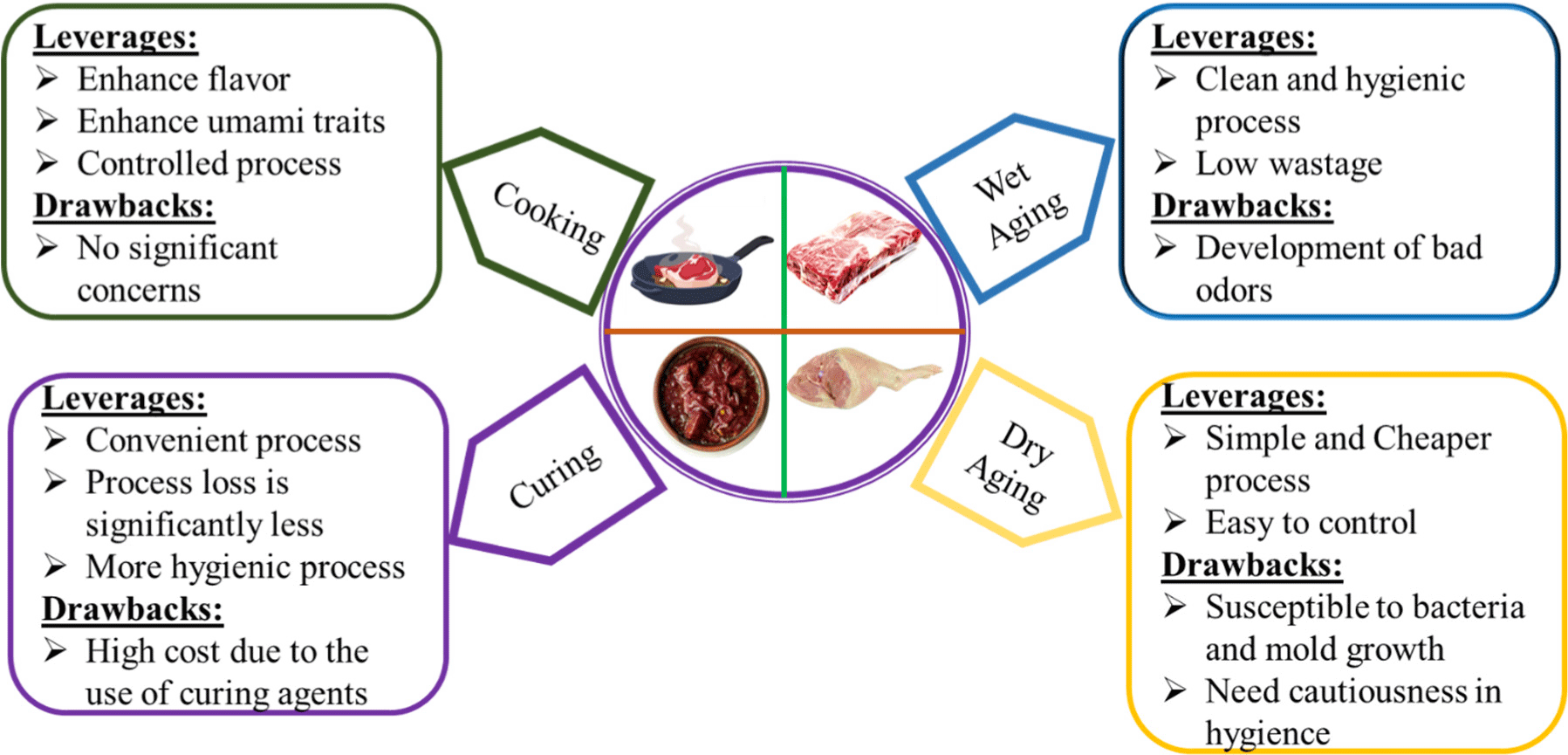
Aging, including dry and wet aging, is a prevalent method in the meat business to augment flavor. Dry aging entails the preservation of beef under regulated humidity and temperature for many weeks, facilitating the action of natural enzymes that decompose muscle fibers, resulting in a more intense, flavorful, and tender product (Dashdorj et al., 2016). In wet aging, meat is vacuum-sealed and refrigerated, permitting it to mature in its own juices. Wet aging often results in a more subdued flavor than dry age, as the meat preserves moisture; yet, enzyme activity continues to enhance a complex flavor profile (Kim et al., 2016).
Marination is a widely employed method to enhance the flavor, softness, and juiciness of meat. Marinades often comprise components such as acids (e.g., vinegar, citrus), oils, and seasonings. Acidic substances decompose proteins, resulting in a more tender product, while aromatic herbs and spices contribute supplementary flavors (Aminzare et al., 2016). An overview of using additives in the quality, taste and flavor development of meat and meat products are summarized in Table 1. Marinades function as vehicles for taste chemicals that engage with the meat, facilitating deeper flavor penetration into the muscle fibers. Moreover, the inclusion of sugar or salt in marinades might facilitate Maillard reactions during cooking, resulting in caramelized tastes and enhanced coloration on the meat’s surface (Latoch et al., 2023).
| Product type | Objectives | Natural additives | Additive concentration (%) in formulation | Salt type | Salt concentration (%) | Main effects | References |
|---|---|---|---|---|---|---|---|
| Pork ham | Flavor improvement | Seaweed extract | 0.11 | NaCl | 1 | Flavor improved | Barbieri et al. (2016) |
| Dry aged beef jerkey | Flavor and tenderness. | Soy sauce | 2 | NaCl | 2 | Flavor and tenderness improved | Lim et al. (2014) |
| Chicken nugget | Tenderness | Mushroom | 2.5 | NaCl | 25 | Tenderness improved | Akesowan (2021) |
| Beef patty | Flavor and lipid oxidation | Mushroom | 2.5 | NaCl | 0.60% | Reduced lipid oxidation and improved flavor | Cerón-Guevara et al. (2020) |
| Dry-cured pork | Flavor | Glasswort extract | 10 | NaCl | 90 | Flavor improved | Ferreira et al. (2022) |
| Tenderness and juiciness | Glasswort extract | 10% | NaCl | 1 | Tenderness and juiciness improved | Lim et al. (2015) | |
| Pork loin | Tenderness and juiciness | Red glasswort | 2 | NaCl | 2 | Tenderness and juiciness improved | Jeong et al. (2020) |
| Synthetic additives | |||||||
| Fermented sausages | Tenderness | Calcium glutamate | 0.03 | NaCl, KCl, Calcium Ascorbate | 2.25+0.42+0.3 | Tenderness improved | Zhang et al. (2021) |
| Flavor | K-lactate | 10 | NaCl, KCl | 50+40 | Flavor improved | Guàrdia et al. (2008) | |
| Pork frankfurter | Texture and flavor | Glycine | 20 | NaCl, KCl | 22.5+57.50 | Texture and flavor improved | Wilailux et al. (2020) |
| Pork sausage | Texture | Maltodextrin+L-Lysine+L-Alanine, Citric acid, Ca-lactate | 3.5+4+1+0.5+1% | NaCl, KCl | 70+20 | Texture improved | Chen et al. (2019) |
Fermentation is extensively employed in the production of cured foods such as sausages and salamis. This procedure entails the incorporation of particular bacterial cultures, such as Lactobacillus and Staphylococcus, into meat, facilitating lactic acid synthesis and reducing the pH level. The acidic environment preserves the meat and increases flavor through intricate biological interactions that release volatile molecules responsible for a tangy and umami-rich character (Lorenzo et al., 2018). Fermentation produces supplementary aromatic chemicals such as aldehydes and esters, enhancing the distinctive aromas of fermented meat products (Hugas and Monfort, 1997).
Smoking is a conventional method that imparts a unique, smoky flavor and preserves the meat. This approach involves exposing meat to smoke generated from wood combustion, which infuses it with phenols, carbonyls, and organic acids that provide aroma and antibacterial characteristics (Pintado et al., 2021). Various woods, including hickory, apple, and cherry, contribute various flavors, as each wood type emits a specific array of aromatic chemicals. Smoking is employed in goods such as ham, bacon, and smoked sausages, where the smoky scent and flavor are much valued (Aaslyng and Meinert, 2017).
Curing entails the application of salt, nitrates, or nitrites to meat, which suppresses bacterial proliferation and facilitates the emergence of distinctive flavors. Salt extracts moisture, intensifying the meat’s flavor and fostering conditions for biological reactions that generate distinct taste and aroma profiles (Toldrá et al., 2012). Nitrate and nitrite curing is crucial for color stability in cured meats, imparting the distinctive pink hue and inhibiting oxidative rancidity, which can adversely affect flavor (Desmond, 2006). This process is crucial in the production of hams, prosciuttos, and other cured meats, where flavor intensity is a defining characteristic.
Biotechnological Methods for Flavor Enhancement
Biotechnology involves several techniques that alter biological creatures or systems to generate or improve flavors. These methods may encompass fermentation, metabolic engineering, and enzymatic procedures to generate preferred flavor molecules in food. The cutting-edge biotechnological methods are illustrated in Fig. 4.
Fermentation has been employed for centuries to enhance flavors in food and beverages. Recent advancements in microbial biotechnology have facilitated more precise fermentation procedures to enhance flavor qualities. Traditional fermentation methods utilizing lactic acid bacteria and yeast have been refined to produce flavors and fragrances characteristic of meat, dairy, or certain plant-based characteristics. Lactic acid bacteria, specifically Lactobacillus and Pediococcus species, can synthesize organic acids, esters, and alcohols that impart a meat-like flavor to plant-based products (Gänzle, 2015).
Metabolic engineering modifies the metabolic pathways of microorganisms to improve the synthesis of particular taste chemicals. In yeast, the metabolic pathways for ester synthesis can be modified to provide flavors akin to those present in cheese, wine, and other fermented goods. Genetically modifying Saccharomyces cerevisiae, a widely utilized yeast in taste manufacturing, to enhance the biosynthesis of isoamyl acetate or ethyl caproate can produce fruity and buttery flavors that are sought after in many plant-based dairy replacements (Ienczak et al., 2022).
Enzymes are crucial for catalyzing processes that generate taste chemicals. Biotechnology utilizes particular enzymes, such as lipoxygenase or peroxidase, to facilitate targeted reactions that produce desirable tastes. Lipoxygenase can transform linoleic acid into volatile chemicals linked to a “meaty” fragrance in plant-based meat. Improvements in enzyme immobilization and stabilization methods have significantly increased the commercial scalability of enzyme technology, facilitating reliable and efficient taste generation in food manufacturing (Hasan et al., 2006).
Genomics has elucidated the genetic foundations of flavor production, facilitating the identification and alteration of genes implicated in flavor pathways. By finding and manipulating these genes, scientists can genetically modify plants, yeast, and bacterial strains to yield various flavor profiles. Genomic research has pinpointed genes that govern the manufacturing of several taste chemicals in plants. In tomatoes, genes like LeHPL and LeCCD1 are recognized for their impact on volatile chemicals that enhance fruity and sweet aromas. Researchers can utilize CRISPR-Cas9 to accurately modify genes, so augmenting the natural tastes of plant components employed in food production (Tieman et al., 2017). Comparable research in soybeans has pinpointed genes that affect unwanted grassy or beany flavors, which can be suppressed or altered to yield a more neutral flavor profile appropriate for plant-based meat (Dixon, 2013).
Genetic alteration is a potent genomics instrument employed to augment flavor. By introducing or overexpressing particular flavor-producing genes, researchers can enhance the synthesis of desirable chemicals in microorganisms or plants. For instance, S. cerevisiae has been genetically modified to express flavor-related pathways from other species, such as Pichia pastoris or Kluyveromyces lactis, thereby augmenting its potential to generate intricate, dairy-like flavors in plant-based dairy substitutes (Steensels et al., 2014).
Epigenetic alterations entail altering the expression of flavor-associated genes without modifying the DNA sequence. This method can regulate gene expression to augment the synthesis of particular tastes in agricultural products. Methylation alterations in tomato plants have been linked to enhanced production of fruity smells (Guo et al., 2018). Epigenetic methodologies are currently developing in flavor biotechnology but show potential for improving flavor profiles in diverse crops without direct genetic alteration.
Fundamental Sensory Attributes of Hybrid and Plant-Based Meat
Hybrid and plant-based meats must emulate essential sensory characteristics of conventional meat, including texture, flavor, appearance which are crucial determinant in consumer choice. In plant-based alternatives, attaining a meat-like texture frequently necessitates the use of binders, such as MTGase, which improves the structural integrity of plant proteins (Baugreet et al., 2018). Conventional meat flavors originate from amino acids and fatty acids, which are difficult to reproduce in plant-based formulations (Kumari et al., 2023). The incorporation of natural flavor enhancers and fermentation techniques can augment the meat-like flavor of alternative goods. Colorants or natural substances, such as beet juice or heme proteins, are employed to impart the distinctive red or pink hue in meat analogs (Kyriakopoulou et al., 2019). Use of scaffolding materials encapsulated with bioactive compounds may improve the taste and flavor of meat analogs (Alam et al., 2024c). Consumers are more inclined to embrace plant-based goods when their flavor closely resembles that of traditional meat (Elzerman et al., 2015). Sensory evaluation methods for any kinds of meat products has been illustrated in Fig. 5. A study conducted by Elzerman et al. (2015) revealed that consumers positively assessed the texture of plant-based meat analogs, while observing flavor discrepancies in comparison to traditional meat. In a separate study, Kyriakopoulou et al. (2019) investigated the impact of ingredient modification on the sensory attributes of restructured plant-based patties, observing that the incorporation of MTGase improved texture, resulting in increased chewiness and firmness. Baugreet et al. (2018) found that in consumer preference testing for hybrid meat products that integrate plant and animal proteins, those exhibiting enhanced juiciness and tenderness received better overall like scores. Alam et al. (2024b) assessed different type of plant ingredients in pork and beef products and hybrid products were well accepted by sensory panel in comparison to reference meat products. Additionally, the umami and richness values were higher in hybrid products. These studies indicate that hybrid products can attract consumers desiring meat substitutes that closely resemble the sensory characteristics of traditional meat.
Conclusion
The integration of traditional and contemporary approaches offers a viable foundation for augmenting the sensory attributes of meat. Although age, marination, and smoking are fundamental approaches, advancements in biotechnology and sensory research present novel potential for flavor enhancement. Enzymatic activity, microbial cultures, and data-driven insights are essential for creating customized flavor profiles that align with changing customer preferences. This collaborative strategy not only improves flavor but also corresponds with the market’s transition towards sustainable and creative food solutions. Subsequent research ought to concentrate on enhancing these technologies to maximize flavor uniformity and user contentment.














